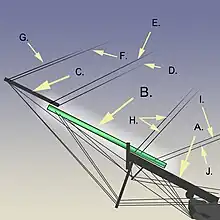Jibboom
A jibboom (also spelled jib-boom) is a spar used to extend the length of a bowsprit on sailing ships.[1] It can itself be extended further by a flying jib-boom.[1] The heel (i.e. rear and lower) end of the flying jib-boom is attached to the jib-boom, and the heel of the jib-boom to the bowsprit. The point (i.e. higher and fore end) of the flying jib-boom is generally the fore-most extent of a ship. The jib- and flying jib- booms carry the tacks of the jib and flying jib sails, respectively, and the stay for the fore topgallant mast and the royal stay.

In yachts it is a boom attached to the foot of the jib, to keep the shape of the sail in different wind angles and to allow self tacking.
Jib-boom
The jib-boom is—as the name suggests—the boom for the jib, extending its foot.[1] On smaller, merchant, sailing ships, it is commonly attached to the bowsprit by a cap and a saddle, either lashed down or secured with a crupper chain.[1][2][3] Alternatively, it can be attached by a boom iron and a cap, or even by two boom irons.[3] The cap and saddle allow it to be withdrawn aft along the bowsprit as a ship enters harbour, reducing the opportunity for passing ships to glance against it and snap it off from the bowsprit.[3]
It is octagonal in cross-section at its heel end.[4] If secured by a chain to the bowsprit, it is iron-scored at the heel.[4] At its point it is also (partly) octagonal in cross-section, the same as is the boom iron that secures the flying jib-boom to it.[4] The flying jib-boom lies against the upper starboard side of the octagon.[4]
The stay of the fore topgallant mast is attached to the jib-boom at the extremity of its point.[1][4][5] The stay for the jib sail is attached to the shouldering at its heel.[4] Just as the bowsprit has bobstays, in order to counteract the upward force from the jib and fore topgallant stays a martingale hangs down from the point of the jib-boom to a dolphin striker, pulling downwards on the jib-boom.[6]
Flying jib-boom
The flying jib-boom is secured, at its heel end, to the jib-boom by a boom iron and lashing.[1] At its point, it has a sheave for the royal stay.[4][5] Another sheave at the heel is for a heel rope.[4] It is to the point that the tack of the flying jib sail is drawn out.[3]
References
Cross-reference
- Smyth 2008, p. 412.
- Nares 1868, p. 45.
- Jamieson 1829, p. 530.
- Boyd 1857, p. 133.
- Moore 1801.
- Biddlecombe 1925, p. 20.
Sources used
- Biddlecombe, George (1925). "Martingale". The Art of Rigging. Dover Maritime Series (reprinted 1990 by Courier Dover Publications ed.). Salem, Massachusetts: The Marine Research Society. ISBN 978-0-486-26343-4.
- Boyd, John M'Neill (1857). A manual for naval cadets (3rd ed.). London: Longman, Brown, Green, Longmans & Roberts. OL 23468580M.
- Jamieson, Alexander (1829). "Jib-Boom". A dictionary of mechanical science, arts, manufactures, and miscellaneous knowledge. Vol. 1. London: H. Fisher, Son & Co.
- Moore, J. J. (1801). "Stay". The British mariner's vocabulary: or universal dictionary of technical terms and sea phrases used in the construction, equipment, management and military operations of a ship. London: Hurst.
- Nares, George Strong (1868). Seamanship (4th ed.). Portsmouth: James Griffin and Co.
- Smyth, William Henry (2008). "JIB-BOOM". In Belcher, Edward (ed.). The Sailor's Word: A Complete Dictionary of Nautical Terms from the Napoleonic and Victorian Navies. Fireship Press. ISBN 978-1-934757-41-3.
Further reading
- Lees, James (1979). "Rigging to the flying jibboom". The masting and rigging of English ships of war, 1625–1860. Naval Institute Press. pp. 52 et seq. ISBN 978-0-87021-847-7.